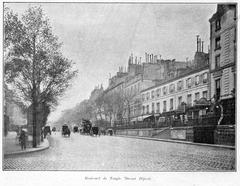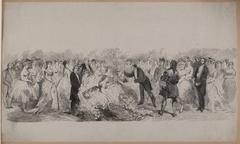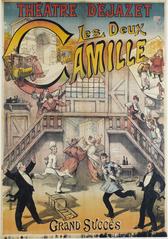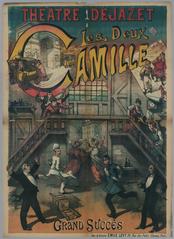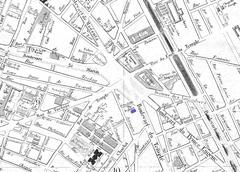
Théâtre Déjazet Visiting Hours, Tickets, and Paris Historical Sites Guide
Date: 14/06/2025
Introduction to Théâtre Déjazet and Its Cultural Significance
In the heart of Paris, Théâtre Déjazet stands as a testament to the city’s enduring theatrical and cultural legacy. Situated at 41 Boulevard du Temple in the historic Marais district, this storied venue is the only remaining theater of the famed “Boulevard du Crime,” and has witnessed the evolution of Parisian entertainment from the late 18th century to the present day. From its beginnings as a jeu de paume built by François-Joseph Bélanger, to its heyday under the artistic direction of Virginie Déjazet and its present-day role as a vibrant performance space, the theater embodies the spirit and resilience of Parisian culture.
Théâtre Déjazet has hosted generations of performers, including icons such as Jacques Offenbach, Coluche, and Kamel le Magicien. Its Italian-style auditorium, adorned with Second Empire details and a ceiling painted by Honoré Daumier, creates an intimate setting where history and artistry converge. Today, the theater offers a diverse program of classical plays, contemporary works, comedy, magic, and family-friendly performances, making it a must-visit for anyone seeking to experience Paris’s rich artistic scene.
For further insights, consult Paris Promeneurs, Wikipedia, and the official Théâtre Déjazet website.
Table of Contents
- Historical Overview
- Visiting Théâtre Déjazet
- Architectural and Cultural Legacy
- Programming and Artistic Offerings
- Visitor Information & Practical Tips
- Frequently Asked Questions (FAQ)
- Conclusion and How to Stay Updated
- References
Historical Overview
Origins and Early Years
The site of Théâtre Déjazet dates to the late 18th century, when architect François-Joseph Bélanger constructed a jeu de paume on the grounds of a former convent (paris-promeneurs.com). During the French Revolution, the building was repurposed as a public bathhouse, reflecting the shifting needs of Parisian society.
The 19th Century and the Boulevard du Crime
In the early 1800s, the Boulevard du Temple—dubbed the “Boulevard du Crime” for its melodramatic crime plays—became the epicenter of Parisian popular entertainment (uniscoops.com). The theater’s site transformed several times: from Les Folies-Meyer café-concert in 1851, to Folies-Concertantes in 1853, and Folies-Nouvelles in 1854, before hosting early works by Jacques Offenbach. By the mid-19th century, the venue emerged as a hub for vaudeville and operetta, democratizing the Parisian stage.
Virginie Déjazet and the Theater’s Namesake
In 1859, celebrated actress Virginie Déjazet acquired the theater, imprinting her vision and elevating its reputation (paris-promeneurs.com). Under her direction, the theater transitioned to classical works and was renamed Théâtre Déjazet in 1880. It flourished with vaudeville and comedic performances, reflecting evolving tastes.
Survival and Reinvention in the 20th Century
Théâtre Déjazet uniquely survived Baron Haussmann’s urban reforms—a fate that led to the destruction of most theaters on the Boulevard du Crime (TheatreOnline). In the 20th century, the venue adapted to changing times, operating as a cinema from 1939 and later alternating between film and stage.
The 1980s marked a new chapter as it became the Théâtre Libertaire de Paris (TLP-Déjazet), hosting chanson artists and avant-garde performances (paris-promeneurs.com). Today, it stands as a lively venue for theater, comedy, music, and magic.
Visiting Théâtre Déjazet
Opening Hours
- Box Office: Generally open from 2:00 PM to 7:00 PM on performance days.
- Showtimes: Performances typically begin between 7:00 PM and 9:00 PM; weekend matinees may be available.
- Guided Tours: Offered occasionally; check the official website for specific dates.
Ticketing Information
- Purchase Options: Online via the official website, at the box office, or through authorized vendors.
- Pricing: Tickets typically range from €15 to €60, depending on the show and seating. Discounts are available for students, seniors, and families (L’Officiel des spectacles).
- Seating: The auditorium seats approximately 530 guests, with excellent sightlines.
Accessibility
- Mobility: The theater is accessible to guests with reduced mobility. Advance notice is recommended for seating arrangements.
- Location: 41 Boulevard du Temple, 75003 Paris. Accessible via Metro (République, Temple, Filles du Calvaire) and bus lines.
Guided Tours & Special Events
- Backstage Tours: Occasionally offered, focusing on the theater’s heritage and architecture.
- Special Events: The calendar includes festivals, comedy nights, and collaborations with other cultural organizations.
Nearby Attractions
- Cultural Sites: Place de la République, Canal Saint-Martin, Musée Picasso, and the Marais district are all within walking distance.
- Dining: The neighborhood offers a variety of cafés, bistros, and restaurants.
Architectural and Cultural Legacy
Interior Features and Monument Historique Status
Théâtre Déjazet’s discreet façade hides an ornate Italian-style auditorium. The highlight is a painted ceiling adorned with fresques by Honoré Daumier, celebrating the theater’s legacy (TheatreOnline). Gilded balconies, plush red velvet seats, and preserved woodwork reflect its Second Empire origins.
The venue was classified as a monument historique in 1990, ensuring the protection of its unique heritage (Wikipedia). Restoration efforts have maintained its character while updating facilities for modern audiences.
Programming and Artistic Offerings
Classical and Contemporary Works
Théâtre Déjazet’s programming blends tradition with innovation. Its repertoire includes plays by Molière, Shakespeare, Feydeau, and Chekhov, as well as new works from Alexis Michalik, Wajdi Mouawad, and Joël Pommerat (L’Officiel des spectacles).
Family-Friendly and Seasonal Events
Theatergoers of all ages will find engaging shows, such as “Kamel le magicien : Crois en tes rêves,” which combines magic and storytelling (Déjazet official site). Seasonal highlights include holiday productions, comedy festivals, and musical spectacles that align with the city’s cultural calendar.
Visitor Information & Practical Tips
Directions and Access
- Metro: République (Lines 3, 5, 8, 9, 11), Temple (Line 3), Filles du Calvaire (Line 8)
- Bus: Several lines stop nearby.
- Vélib’: Public bike stations are close.
- Car: Limited parking—public transport is recommended.
Amenities and Accessibility
- Restrooms and Cloakroom: Available on-site.
- Refreshments: Light snacks and drinks at the theater bar during intermissions.
- Accessibility: Notify the theater in advance for assistance.
Dining and Attractions Nearby
- Enjoy pre- or post-show meals at local cafés and bistros.
- Explore Marais district sights, including the Musée Picasso and Canal Saint-Martin.
Visitor Tips
- Arrive at least 30 minutes before showtime.
- Dress: Smart casual.
- Photography: Allowed before/after performances; prohibited during shows.
- Language: Productions primarily in French (check for surtitles).
- Children: Age suitability varies by show.
Frequently Asked Questions (FAQ)
Q: What are Théâtre Déjazet’s visiting hours?
A: Box office is open from 2:00 PM to 7:00 PM on performance days; showtimes generally start at 7:00–9:00 PM. Matinees are available on some weekends.
Q: How can I buy tickets?
A: Purchase tickets online at the official website or at the box office.
Q: Is the theater accessible for visitors with disabilities?
A: Yes, but due to the historic structure, some restrictions apply. Contact the theater in advance to arrange accommodations.
Q: Are guided tours available?
A: Occasionally, especially during special events. Check the official site for details.
Q: Can I take photos inside?
A: Permitted before and after performances; not during shows.
Q: What nearby attractions can I visit?
A: Place de la République, Musée Picasso, Canal Saint-Martin, and the Marais district.
Conclusion and How to Stay Updated
Théâtre Déjazet is a living symbol of Parisian theatrical tradition and innovation. Its rich history, architectural beauty, and dynamic programming make it an essential stop for anyone exploring Paris historical sites. Whether you attend a performance, join a guided tour, or simply admire its storied façade, you’ll experience a unique slice of Parisian culture.
Stay updated on shows and special events by visiting the official Théâtre Déjazet website and following their social media. For personalized guides and exclusive content, download the Audiala app.
References
- Théâtre Déjazet: Visiting Hours, Tickets, and History of Paris’s Legendary Theatre, 2024, Paris Promeneurs (https://paris-promeneurs.com/le-theatre-dejazet/)
- Architectural and Cultural Significance, 2024, Wikipedia and TheatreOnline (https://fr.wikipedia.org/wiki/Th%C3%A9%C3%A2tre_D%C3%A9jazet), (https://www.theatreonline.com/Theatre/Theatre-Dejazet/256)
- Théâtre Déjazet: Visiting Hours, Tickets, and Paris Historical Site Guide, 2024, L’Officiel des spectacles (https://www.offi.fr/theatre/theatre-dejazet-1987/kamel-le-magicien-crois-en-tes-reves-89003.html), (http://www.dejazet.com)
- Théâtre Déjazet Visiting Hours, Tickets & Guide to Paris Historical Sites, 2024, 75.agendaculturel.fr (https://75.agendaculturel.fr/theatre-dejazet), (http://www.dejazet.com)

